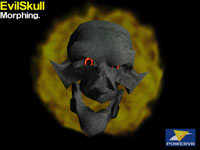Graphics core vendor rev’s SDK for content creators
Aug 1, 2006 — by LinuxDevices Staff — from the LinuxDevices Archive — 4 views Imagination Technologies is shipping a new version of its SDK (software development kit) for content developers targeting mobile phones and handheld devices equipped with “PowerVR” graphics cores. The PowerVR Insider SDK 1.9 offers broad hardware, 3D API, and OS support, including support for embedded Linux.
Imagination Technologies is shipping a new version of its SDK (software development kit) for content developers targeting mobile phones and handheld devices equipped with “PowerVR” graphics cores. The PowerVR Insider SDK 1.9 offers broad hardware, 3D API, and OS support, including support for embedded Linux.
(Click for larger version of PowerVR “PolyBump” demo clip screenshot)
Imagination is best known for IP (intellectual property) used in SoC (system-on-chip) designs. Its graphics cores are resold by ARM, and used in Texas Instruments's OMAP2 SoCs such as the OMAP2420, as well as in Freescale's ARM11-based i.MX31. Freescale, for example, touts the PowerVR MBX Lite as the “defacto standard for high performance graphics and video on mobile phones and PDAs.”
The PowerVR Insider SDK 1.9 supports some 30 variants of the PowerVR graphics core, according to Imagination, along with OSes that include Linux, Windows CE, Windows Mobile, and Symbian. The SDK actually comprises several separate SDKs targeting various APIs, including:
- Khronos Group's OpenGL ES 1.x (embedded subset) for PowerVR MBX cores
- Microsoft's Direct3D Mobile API for PowerVR MBX cores
- Khronos Group's OpenVG for PowerVR MBX and SGX
Additionally, an OpenGL ES 2.0 SDK beta is available, for PowerVR licensees with “shader based” embedded projects. An additional benefit of OpenGL ES is that 3D code can be “directly ported” from PC-based development hosts, Imagination says.
Availability
 The PowerVR SDK appears to be available now. It includes tools and utilities; PC emulation for OpenGL ES and Direct3D Mobile; and PVRTextureTool, PVRTC library, PVRMAXExport, and VGPCompiler. It also comes with tutorials, source code, documentation, extensions specifications, a platform abstraction framework, and an extensible tools library, Imagination says.
The PowerVR SDK appears to be available now. It includes tools and utilities; PC emulation for OpenGL ES and Direct3D Mobile; and PVRTextureTool, PVRTC library, PVRMAXExport, and VGPCompiler. It also comes with tutorials, source code, documentation, extensions specifications, a platform abstraction framework, and an extensible tools library, Imagination says.
Also available are dozens of fun 3D demo clips (MPEG files), such as the “Evil Skull” pictured at right, from Imagination's OpenGL ES product page.
This article was originally published on LinuxDevices.com and has been donated to the open source community by QuinStreet Inc. Please visit LinuxToday.com for up-to-date news and articles about Linux and open source.